Congratulations on your first step toward expanding your business – expanding your industrial operations is a major milestone. The way you build your facility, whether it is a new manufacturing plant or expanding an existing one, efficient factory planning is very crucial to support your business needs.
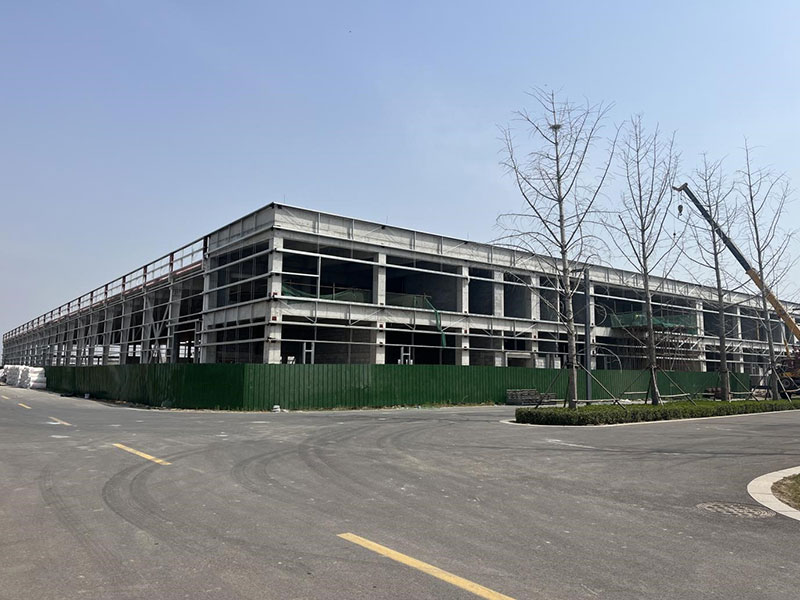
In modern times, steel structures have become the industrial factory solutions worldwide. From manufacturing electronics and food processing to heavy equipment assembly, steel offers many advantages in strength, speed, flexibility, and long-term value. And compared to the traditional canstruction, steel buildings allow faster building time, lower maintenance, and easy future expansion.
Let’s take a closer look at why more and more companies are choosing steel frame factories over traditional ones. We’ll explore the different types of steel used in factory buildings, how it compares to traditional buildings, and why it’s a smarter, safer, and more sustainable choice for forward-thinking businesses.
Why Are More Factories Built with Steel?
Modern factories are no longer just spaces for machines – they are hubs of innovation, logistics, and manufacturing designed to meet growing demands. For businesses to keep up, they need facilities that are quick to build, strong enough to last, and flexible to expand as needed. Steel structures check all those boxes and more.
Unlike the traditional brick-and-mortar or concrete buildings, steel frames can be easily prefabricated, transported, and assembled, reducing construction time significantly. Steel is also lighter than traditional materials, which lessens the load on foundations without compromising stability.
Take Tesla’s Gigafactory in Shanghai as a prime example. This massive production facility was built using steel structure systems and prefabricated components. The construction commenced in January 2019, and the first vehicles rolled off the line by October of the same year. Completing a factory of that size in a timeline of less than a year is very impressive, and this was made possible by the speed and efficiency of steel construction.
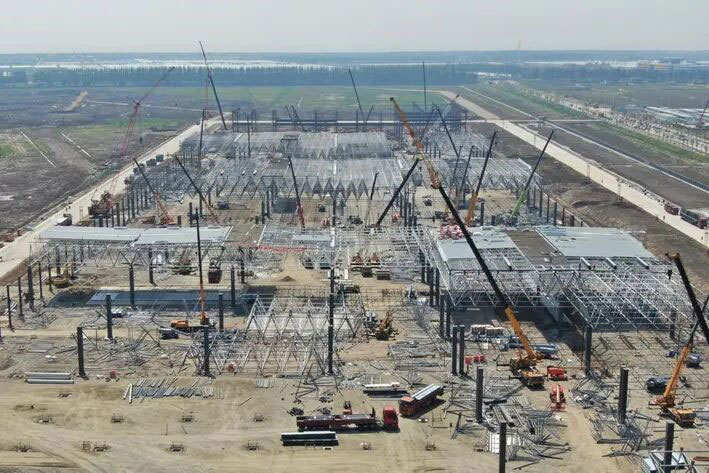
Another example of a steel factory in Hefei for a vehicle manufacturer company: Anhui Feixi New Energy Vehicle Intelligent Industrial Park (Space Truss Structure) 171
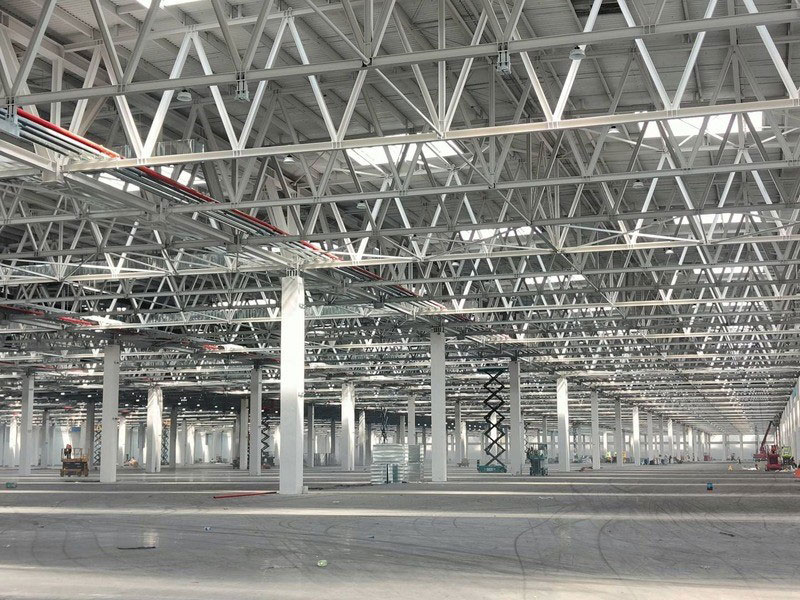 Steel’s advantages don’t stop at speed and strength—it also offers flexibility to support business growth, ensures safety in extreme conditions, and delivers long-term cost savings through reduced labour and low maintenance. That’s why steel has become the industrial factory solution worldwide.
Steel’s advantages don’t stop at speed and strength—it also offers flexibility to support business growth, ensures safety in extreme conditions, and delivers long-term cost savings through reduced labour and low maintenance. That’s why steel has become the industrial factory solution worldwide.
What Kind of Steel Is Used in Factory Buildings?
You don’t need to be a structural engineer to understand which steel to use. However, using the right kind of steel for the right part of the structure will make a difference.
To simplify it, here are the combinations that most factories use:
- Galvanized Steel for Walls and Roofing Panels
Galvanized steel is steel that has a protective zinc coating, which prevents rust and corrosion, making it perfect for a manufacturing environment, especially in humid or chemically exposed areas.
Why does it work? It is durable, reduces maintenance costs, and has the ability to maintain a clean appearance (no rust and corrosion), which is important for industries like food processing, chemical production, and/or manufacturing.
- Cold-Formed Steel (CFS) Components for Interior Spaces
Cold-formed steel (CFS) or light-gauge steel is a type of steel formed using cold-working processes like rolling, pressing, or stamping. This type of steel is popular for its fire resistance, recyclability, light weight, durability, and cost efficiency.
This type of steel is ideal for partition walls, staircases, or any interior parts that do not need to support heavy loads.
Why does it work? It’s quick to install, cost-effective, durable, and has the flexibility for any interior use.
- Standardized Portal Frame
These components are used as the bones of the building – the big, bold steel columns and beams that hold the whole structure. If you have ever seen a factory or any industrial building with wide open space, no columns getting in the way, that is likely the work of structural steel.
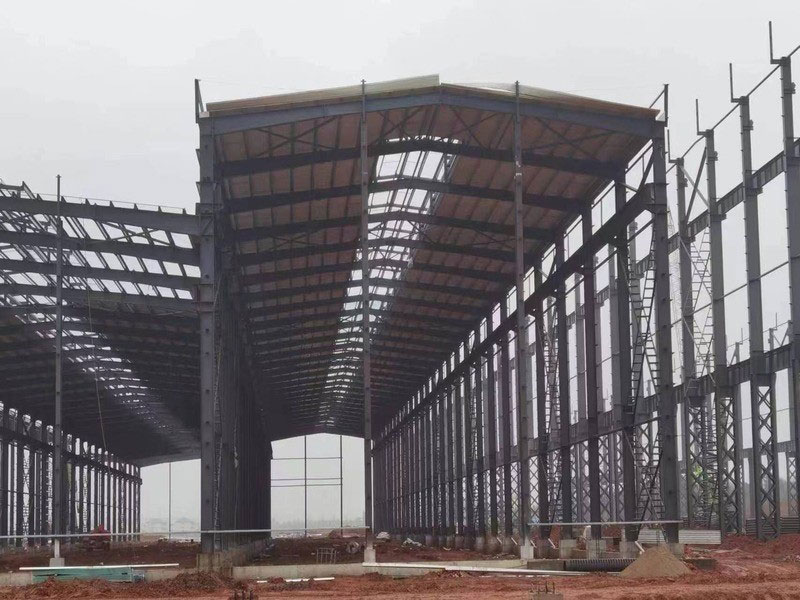
Please refer to our Standardized Rigid Portal Frame for detailed information, or see its application in our Ruifut large-scale steel structure plant project.
Why does it work? It has the ability to support heavy loads, high ceilings, and wide open spaces without compromising the stability of the construction.
Steel vs. Traditional Factory Construction: What’s the Difference?
Most traditional factories were built using materials like concrete, brick, mortar, or timber. And now, let’s compare the real advantages between the traditional and steel frame factory.
| Feature | Traditional Factory | Steel Structure Factory |
| Build Time | Take several months or more, often delayed or slowed down due to weather conditions. | Take weeks or months to complete – construction is faster and can be planned ahead. |
| Labor | Requires more on-site workers for longer periods. | Reduced on-site workers with prefabricated parts, and shorter assembly time. |
| Weight | Heavy, requires deep and expensive foundations. | Lightweight but strong, they require simpler foundations. |
| Expansion | Expansion or renovation is complicated, costly, and disruptive. | Designed for easy upgrades, extensions, or layout changes. |
| Environmental Impact | Generates more waste. | Cleaner process with less waste. |
One of the biggest advantages of steel structure is its flexibility, which none of the traditional buildings have.
Steel structures allow you to update your factory layout over time or even rapidly if needed. Adding a new production line? That will not be an issue. Need more space for the loading dock? Certainly can. And the most important thing is that this renovation process will not interrupt the entire operation, as it can be done without knocking down any walls – what a perfect Custom Industrial Factory Solutions.
Why Steel Structures Are Safer for People and Smarter for Facilities?
In a high-risk industrial environment, safety is crucial – it is not an option. Whether it is a chemical plant, electronics factory, or any mass production facility, it is important to know how your building handles an emergency situation, from fire and natural disasters like earthquakes to internal accidents, as it will directly impact the safety of your workers, equipment, and business continuity.
And this is exactly how steel structures become the industrial factory solutions, outperforming the traditional materials.
Concrete can crack under seismic stress, and brick can collapse under fire. However, steel frames can survive without breaking during an earthquake, and they are more fire-resistant, especially when treated with a special protective coating. In case of a fire or explosion, steel is designed to hold structural integrity longer, providing extra time for workers to evacuate safely while reducing the risk of a total collapse.
Why does it matter? In facilities where flammable materials, heavy machinery, or high-voltage systems are present, the ability of a building to handle extreme conditions can prevent disasters from escalating and save lives.
However, safety is not just about strength, but also about speed and adaptability. Steel buildings often use modular and prefabricated components, and when there is any internal accident occurs (such as hazardous material spilled or malfunctioning equipment), new safety systems, containment zones, or evacuation routes can be installed quickly with minimal downtime.
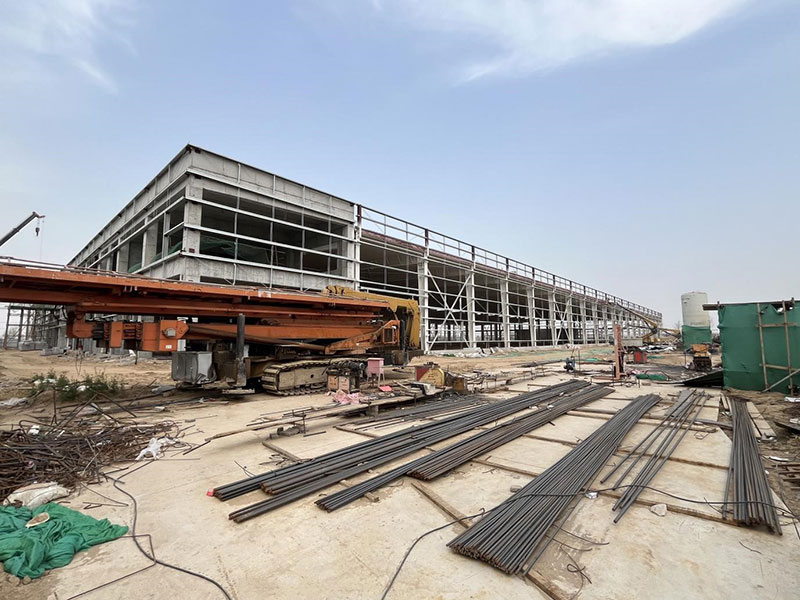
Bottom line, steel structure isn’t just an Industrial Factory Solution; it helps you to grow, survive, and protect the people inside. In industries where the unexpected happens, steel can be the safety solution.
What about the cost?
Let’s talk numbers – is steel really more expensive?
It’s a common assumption that steel factories come with a higher cost, but we need to look at the bigger picture, where steel often turns out to be the more cost-effective solution.
Here are the reasons:
| Category | Traditional Construction | Steel Structure |
| Labor Cost | High | Lower, due to fast assembly |
| Maintenance | Frequent repairs | Low maintenance |
| Construction Time | Several months | Weeks |
| Expansion Cost | Expensive and complex | Lower cost and flexible |
Besides the above reasons, prefabricated steel minimizes the waste of the construction. It is also energy efficient and has the ability to cut utility bills with better insulation and smarter layouts.
Yes, at first glance, a steel factory looks like a big investment – but consider this:
- Faster building time = Lower labor costs
- Less construction waste = Lower material costs
- Durability = Lower maintenance and repair costs
- Flexibility = Easy to expand or reconfigure without a full rebuild
Every project is different, but with XTD Steel Structure, most projects are completed up to 50% faster than traditional construction, resulting in 10–20% savings on overall construction costs – a real cost-effective solution.
Check our previous blog on how steel structure has also become a cost-effective solution for the 2022 FIFA World Cup: Steel Structure and Its Cost-Effectiveness Analysis: The 2022 FIFA World Cup as an Example.
Let’s Build Smarter with XTD Steel Structure
At XTD Steel Structure, we believe that a successful business begins with efficient factory planning. That’s why we don’t just supply materials, but we work collaboratively with you to find the best industrial factory solutions to your specific needs.
Using modular design, prefabricated components, and smart planning, we promise to help you get your facility up and running faster, more cost-effectively, and adaptably to your business growth. Let’s build something that works now and works even better in the future.
Ready to get started? Contact XTD Steel Structure for a free consultation or explore our steel structure projects to view our past work.
